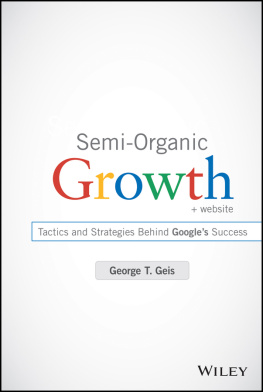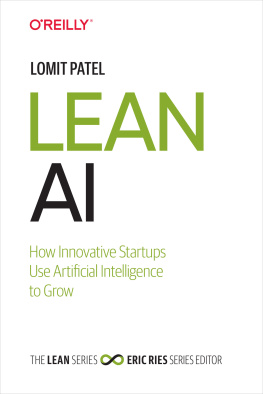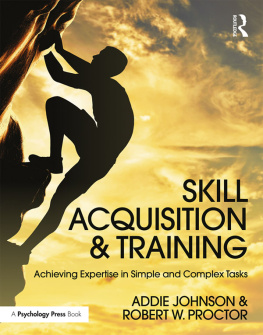THE SYNERGY TRAP
THE SYNERGY TRAP

How Companies Lose the Acquisition Game
MARK L. SIROWER
THE FREE PRESS

THE FREE PRESS
A Division of Simon & Schuster Inc.
1230 Avenue of the Americas
New York, NY 10020
Copyright 1997 by Mark L. Sirower
All rights reserved, including the right of reproduction in whole or in part in any form.
THE FREE PRESS and colophon are trademarks of Simon & Schuster Inc.
Manufactured in the United States of America
Library of Congress Cataloging-in-Publication Data
Sirower, Mark L., 1962
The synergy trap: how companies lose the acquisition game / Mark L. Sirower.
p. cm.
Includes index.
1. Consolidation and merger of corporationsUnited States. 2. Tender offers (Securities)United States. 3. Management buyoutsUnited States. 4. CompetitionUnited States. 5. RiskUnited States. I. Title.
HD2746.55.U5S57 1997
338.830973dc20 96-44862
CIP
ISBN-13: 978-0-6848-3255-5
eISBN-13: 978-1-4391-3770-3
www.SimonandSchuster.com
To Mom and Dad
You will always be my greatest teachers
Contents
Preface
The M&A wave of the 1980s has become the tidal wave of the 1990s. In 1999 alone, merger and acquisition announcements totaled over $3 trillion. Although much has been written over the past three decades about these major corporate investment decisions, the fundamentals of acquisition performance have remained a mystery.
This book grew out of my doctoral research and through a course I developed, called The Management of Corporate Merger and Acquisition Strategies, for MBAs and executives at Columbia Business School. The objective of the book is to break down the walls between finance and strategic managementand to expose the foundations of performancein the vitally important area of acquisitions. Indeed, it is precisely the walls dividing the two fields that have given rise to unexamined and misleading folklore about the so-called keys to acquisition success.
Most prior research on mergers and acquisitions has reflected the divisionalized nature of business schools. Financial perspectives have ignored the competitive and organizational realities, and strategic management perspectives have been devoid of the finance so essential for an understanding of the value of investment decisions. A major result is that synergy has remained a vague and even mysterious conceptwith little financial or strategic meaning. Unfortunately, in practice the use of sophisticated valuation models, combined with a poor understanding of what, exactly, synergy is, has caused the justification of many predictably bad acquisitions and the destruction of billions of dollars of shareholder value in acquiring firms.
Amid all the excitement surrounding M&A activity, it is easy to forget that acquisitions are strategic alternatives. CEOs, executive teams, and boards of directors readily choose acquisitions over other investment alternatives, paying substantial premiums in the process. They often fail to consider that it is incorrect to judge the soundness of an acquisition decision on the basis of what it would cost the company to develop that particular business from scratchan idea that may have been a value-destroying decision on its own. In fact, acquisitions are unique alternatives and the success of these strategic decisions must be judged by their effects on the wealth of the ownersthe shareholdersof the acquiring company.
It is the payment of an acquisition premium that sets up the unique business gamble that acquisitions represent. The premium forces a consideration of the performance already embedded in preacquisition share prices and the improvements in performance that will be required. In turn, these considerations give rise to the precise meaning and the competitive nature of synergy itselfa major component of this book.
When I first became interested in studying the managerial significance of the acquisition premium as a doctoral student at Columbia over seven years ago, a senior strategy professor challenged my ideas by saying, Acquisition premiums are not a management issuethats a finance topic. Although I knew this meant there would be a struggle ahead, the statement assured me there was an important opportunity to get to the heart of acquisition performance. The book is the result of a long journey. I hope the fundamentals of the acquisition game developed herein will set the stage for more thoughtful acquisition decisions and for future scholarly work on acquisition strategies.
The book is divided into two parts, beginning in rather shallow water and getting deeper as the book progresses. Part 1 presents the elements of acquisition performance, developing the competitive principles behind synergy and the economics of the acquisition premium. In particular, Chapter 4 integrates and extends the financial and strategic concepts presented in Part 1 and gives useful tools and lessons for anyone involved in acquisition decisions. This chapter is essentially a short course for managers, directors, investment bankers, and consultants involved in acquisitions.
Part 2 presents an extensive analysis of the performance of corporate acquisition strategies, incorporating and examining the elements of Part 1. Chapter 6, which details the methodology behind the study, can be bypassed by the manager who wants to get right to the discussion of the results in Chapter 7. Finally, Chapter 8 discusses the implications and contributions of the two parts of the book.
There are a number of people I would like to acknowledge for their contributions and support while I completed the book and the research behind it. First, I owe a very special thanks and an intellectual debt of gratitude to industrial-organization economist Dennis C. Mueller and the legendary chairman and CEO of Cooper Industries, Robert Cizik. Their contributions, over the past thirty years, to the academic literature and to the practice of acquisitions, respectively, have had a major impact on my thinking on acquisitions. In addition, I benefited greatly from their comments, advice, and encouragement during the process of writing the book.
I must thank my professors at Columbia University who allowed me the opportunity to pursue interdisciplinary work during my years in the business school. Ellen Auster, Warren Boeker, James Freeman, Kathryn Harrigan, Gailen Hite, and Boris Yavitz gave encouragement when this book was only ideas. Gailen Hite, my mentor and friend, guided me through the demands of the research on which this book is based. It will always be an honor to have worked with a scholar of his integrity. I am grateful to Kathryn Harrigan for encouraging me to transform this research into a book and, particularly, to publish with The Free Press. On both counts, it was truly a rewarding experience.
I also must thank my colleagues in the management department at the Stern School of Business at NYU for their support for the writing of this book. In particular, I must thank William Guth, Robert Lamb, and William Starbuck for convincing me to take the underlying research and open the ideas to managers. I am also grateful to my colleagues Rikki Abzug and Joseph Lampel for countless hours of helpful advice during the project. Karen Angelillo and Li Yang provided invaluable administrative support throughout.
In the process of presenting pieces of this work in various stages of development at universities and to executives, several people gave many insightful comments and suggestions. As with so many things in life, it is those little things here and there that add up over time. These people include: Bernard Black (Columbia Law School), Glynn Bolar (AT&T), David Collis (Harvard Business School), Bruce Greenwald (Columbia Business School), Philippe Haspeslagh (INSEAD), Robert Klemkosky (Indiana), Keith Kostuch (The Boston Consulting Group), Stephen OByrne (Stern Stewart & Co.), Jeff Phillips (Coopers & Lybrand), Mark Shanley (Northwestern), L. G. Thomas (Emory), Sheridan Titman (Boston College), Jeff Salzman (CS First Boston), Harbir Singh (Wharton), Nikhil Varaiya (San Diego State), Theo Vermaelen (INSEAD), and Feng Ye (Deutche Morgan Grenfell).
Next page










